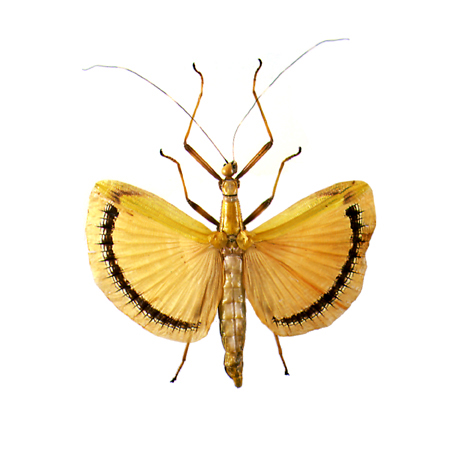
Phasmatodea (=Phasmatoidea) - The Walkingleaves and Walkingsticks
Phasmatodea is the ordinal name given to the walkingsticks (stick insects) and the walkingleaves (leaf insects). These amazing insects best demonstrate the close relationship between insects and plants. Evolving from the Orthoptera sometime during the Triassic period (190-225 million years ago), the mimicry of foliage has become a fine art to the Phasmatodea. Looking exactly like the plants on which they feed (their eggs have evolved to look like seeds), they rely on their camouflage to escape predation. The name Phasmatodea is derived from the Greek word "phasm", meaning phantom. It refers to the cryptic appearance and behavior of these insects. In a few species of walkingsticks, when camouflage fails, they are able to flash brilliantly colored wings in an attempt at distraction and escape. There are about 2,500 described species of walkingsticks but only about 50 known species of walkingleaves. All Phasmatids exhibit incomplete metamorphosis, with nymphs that usually look like tiny versions of the adults. In some species of walkingsticks, the nymphs look and behave like ants while in the first few instars. This mimicry was devised to avoid predation since many animals do like to eat ants. Often abundant in the tropics, where they can grow to gigantic proportions, walkingsticks are some of the largest insects. In fact, with a body length of 25cm (10”) and legs as long as 10cm (8”), Phobaeticus serratipes certainly wins for the category of "World Biggest Insect", at least in our book. The Phasmatodea are vegetarians and, generally, passive. In fact, they are one of the few insect orders that are exclusively vegan (even butterflies and moths feed on “things” other than nectar). Another interesting habit of the Phasmatodea is their ability to reproduce parthenogeneticly; that is, females clone themselves. In some species, males are unknown. Because sticks are different than leaves, the Phasmatodea are broken down into two families: the Phyllidae (walkingleaves AKA leaf insects) and the Phasmidae (=Phasmatidae) (walkingsticks AKA stick insects).
Phasmidae (=Phasmatidae) - Walkingsticks AKA Stick Insects
 Two-Striped Walkingsticks (Anisomorpha buprestoides)
Two-Striped Walkingsticks (Anisomorpha buprestoides)
 Northern Walkingsticks (Diapheromera femorata)
Northern Walkingsticks (Diapheromera femorata)
 Spiny Devil Walkingsticks (Eurycantha horrida)
Spiny Devil Walkingsticks (Eurycantha horrida)
 Walkingstick (Euryncema goliath)
Walkingstick (Euryncema goliath)
 Walkingsticks “Macleay's Spectre” (Extatosoma tiaratum)
Walkingsticks “Macleay's Spectre” (Extatosoma tiaratum)
 Walkingsticks “Green Tree Nymph” (Heteropteryx dilatata)
Walkingsticks “Green Tree Nymph” (Heteropteryx dilatata)
 Great American Walkingsticks (Megaphasma dentricus)
Great American Walkingsticks (Megaphasma dentricus)
 Giant Walkingstick (Phobaeticus (=Pharnacia) serratipes)
Giant Walkingstick (Phobaeticus (=Pharnacia) serratipes)
Phyllidae - Walkingleaves AKA Leaf Insects
![]() Walkingleaf (Phyllium celebicum)
Walkingleaf (Phyllium celebicum)
![]() Walkingleaf (Phyllium frondosum)
Walkingleaf (Phyllium frondosum)

